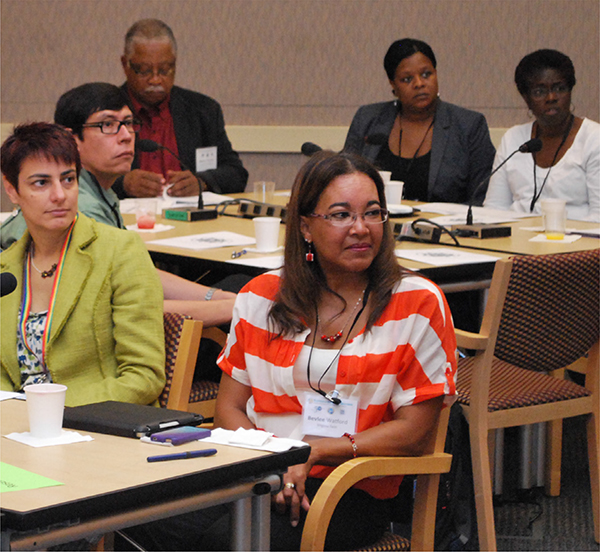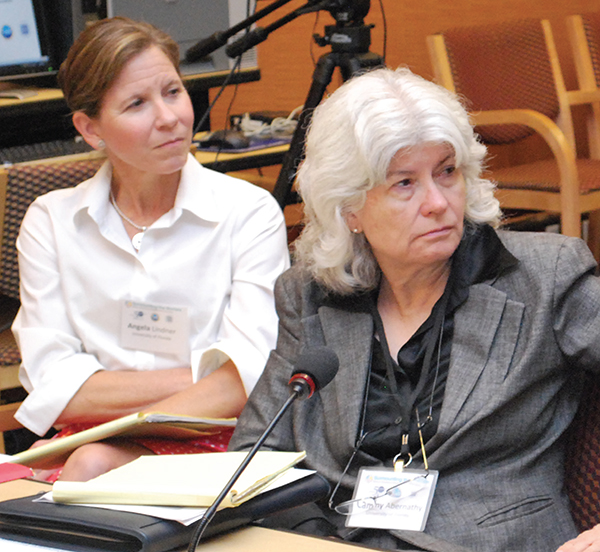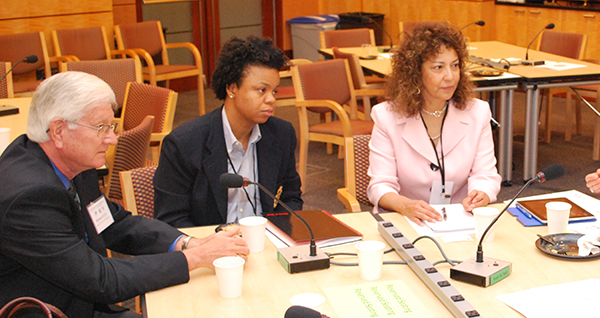SECTION IV—WORKSHOP DISCUSSIONS
A Regional Scale-up Initiative: The Florida Example
The closing first-day plenary session was devoted to identifying key impediments to implementing prior recommendations to greater diversity in engineering education. On the second day, attendees had the same overall charge, but this time they were organized by region, so each breakout group shared a common frame of reference as to any regional considerations that might factor into the failure to implement change. This section looks at how a regional initiative—in this case, involving colleges and universities in Florida—might serve as a scalable example for other states or regions.
Most attendees were impressed by a comprehensive plan for change that was developed at the conference by representatives from Florida colleges and universities. The Florida breakout group described a series of local successes, impediments that might inhibit the scale-up of these successes, and some strategies for overcoming the impediments.
The problems identified by the Florida breakout group in the development of their comprehensive plan were many. Some were common to colleges and universities in other regions, such as institutional indifference to change. Others were more specific to Florida, or more urgent because of local conditions, such as admission decisions made without input from colleges of engineering, and financial aid decisions based solely on merit and not on both merit and need. After due consideration, however, the Florida members of the workshop agreed to undertake a “meeting of the willing” during the winter of 2013-2014 to discuss and expand on local successes, especially new collaborative models with community colleges.
The following summary of the Florida breakout session was prepared by Angela S. Lindner, Associate Dean for Student Affairs at the University of Florida.
Introductory Discussion: State-specific Concerns
• The University of Florida budget model is known as RCM, for Responsibility-Centered Management. Attendees said this has been a barrier in many ways. In essence, RCM decentralizes decisions and financial authority, favoring academic units (colleges); ideally, it encourages these units to take greater responsibility for revenue generation and spending decisions, and units that find new ways of generating revenue do well under this model. Information about this model in higher education is available at the following links, along with viewpoints on its benefits and risks:
o http://cfo.ufl.edu/wp-content/uploads/2012/09/IntrotoRCM.pdf
o www.uky.edu/Provost/FinancialModel/files/Education_Training/RCM_at_major_public_universities.pdf
o www.insidehighered.com/news/2010/12/13/budget
o www.nea.org/assets/img/PubThoughtAndAction/TAA_97Spr_07.pdf
• There is concern at Florida universities about impending cuts to the Florida Bright Futures Scholarship Program. As state funds for this program diminish, the state legislature has threatened to increase the merit standards—namely SAT and ACT scores—for eligibility for these funds. These changes may have a negative impact on minority students, although the representative from Florida A&M University reported that many of that school’s engineering students are not in the Bright Futures Program. More information is provided in the links below.
o www.floridastudentfinancialaid.org/ssfad/bf/
Local Successes, Impediments, and Strategies
The remainder of the discussion focused on identifying local successes, possible impediments to replicating them, and potential strategies for overcoming impediments. The discussion is summarized in Table 3.
Table 3. Local Successes, Impediments, and Strategies: The Florida Example
| Local Success | Possible Ethnic Diversity Impediments | Potential Strategies for Overcoming the Impediments |
| The University of Florida’s (UF) Florida Opportunity Scholars Program (http://fos.ufsa.ufl.edu/) provides funding and support services for first-generation students from low-income backgrounds. The program is responsible for retention rates that equal or exceed the average UF undergraduate population retention rate. |
|
|
| One faculty member noted the difference a single leader can make in terms of support for diversity in a department. In this case, there was a departmental culture change as the result of a single chair, although this was undercut when the chair left and the department reverted to its old ways. (The conversation then turned to how a department or college can institutionalize the good that one enlightened leader begins.) |
|
|
| The new Gator Engineering at Santa Fe Program at UF (www.eng.ufl.edu/gesf/; in its first year in 2013) was established by the UF College of Engineering in collaboration with the UF and Santa Fe College offices of admissions, registrar, and financial affairs. The program allows the college to select a pool of freshman applicants who are not ready to be admitted to UF. Instead, they take chemistry, math, and physics classes, along with other general education courses, at Santa Fe College, a community college, for a maximum of three semesters. The unique aspect of this program is that the attendees become UF students at the beginning of their second semester with all the rights and privileges of a UF student while taking courses at Santa Fe. Since the pool of eligible students will most likely be diverse, this allows the UF College of Engineering to nurture diversity in its undergraduate student population. |
|
|
| STEPUP, UF’s College of Engineering freshman bridge program now entering its 20th year, targets underrepresented students in engineering (www.eng.ufl.edu/students/freshmen-programs/stepup/). Funded strictly from personal and corporate donations to the UF Foundation, the year-long program has a strong track record of increasing retention of students through their first year in engineering. The critical summer component provides students with preparatory instruction in calculus, chemistry, physics, engineering design, modeling, and professional development. Peer mentors are hired to guide the students throughout the year. Students do not register for courses until their fall term, and the college covers the costs of room and board, food, supplies, etc. during the six-week summer term. This program provides a spotlight for employers seeking diversity in their internship and permanent employment pools. Numerous scholarships exist for students who have participated in this program. A newly endowed program, STEPOUT, covers the cost of experiential learning opportunities (research, study abroad, etc.) for STEPUP students in years 2-4. |
|
|
| Hire Federal Work-Study students for undergraduate research. This approach has been pursued successfully by the University of Southern Florida, where students are paired with graduate students for a richer experience. |
|
|
| UF and FAMU regularly track student retention, where students go after graduation, and which students leave the university before graduating. Many universities and some colleges have information systems staff who are dedicated to pulling data. Through close tracking of students by cohort (gender, ethnicity, participation in retention programs, etc.), colleges can assess vulnerable populations in need of support and the effectiveness of existing support programs (including advising). |
|
|
Closing Discussion
One attendee argued that institutions that serve mid- and lower-tier students do as much as or more for the country than those serving only top-tier students, and that more students are prepared for engineering as a result. It was suggested that national rankings could include the impact of these programs on the economy.
Energized by the ideas shared in this discussion and by new connections, the attendees committed to gather again in Florida to continue brainstorming about the potential for collaborative efforts to increase diversity in the engineering student population throughout the state. While details were not final at the end of the workshop, the gathering was planned and held in August 2014 at the University of Florida campus in Gainesville. Representatives from Texas at the workshop planned and held a similar follow-up meeting in February 2014.

Understanding the Key Underlying Impediments to Implementing Prior Recommendations
Much of the first day of the workshop was dedicated to breakout sessions, where discussions were informed by identification of impediments in the pre-workshop surveys (presented in Appendix C). Each group addressed one of the six strategies for achieving diversity listed in Table 2 and impediments to their adoption.
A. Inculcate and reinforce students’ academic and professional knowledge
B. Enhance pedagogy for current and future teachers and faculty
C. Strengthen organizational receptivity to ethnic diversity
D. Enhance economic enablement of students and student support organizations
E. Enhance stakeholder communication and action
F. Increase education research and policy development
After the workshop, Roberta Spalter-Roth, Director of the Department of Research and Development at the American Sociological Association (ASA), and two additional researchers at ASA reexamined the pre-workshop surveys and the breakout group outputs (Appendix D) to further categorize and refine the core impediments underlying the problem. They developed an untested coding scheme for common impediments that achieved a reasonable level of inter-rater reliability, resulting in identification of the following six major types of impediments, with associated “symptoms”:

I. Lack of Incentives or Financial Support
- Inadequate faculty incentives
- Lack of institutional incentives
- Inadequate funding
- Lack of sustained funding because funding sources tend to favor flashy or new programs
- Funder policies that favor short, three- to five-year grants
- Inadequate flexibility from grant funders on what is done, how, and how long
II. Unsupportive Institutional and Faculty Culture and Environment
- Indifferent faculty culture
- Inadequate faculty commitment
- Cultural stereotypes, insufficient cultural competency, and lack of cultural sensitivity training
- Cultural, organizational, and individual issues
- Nonconducive environment
- Size, proximity, and geographic isolation of faculty
III. Lack of Institutional and Constituent Engagement
- Inadequate constituent community engagement
- Constituencies pitted against each other
- Unrealistic industry expectations of student knowledge, skills, and abilities at graduation
- Insufficient ownership by funders and institutions
IV. Systemic Problems among Institutions of Higher Education
- Failure of colleges/universities to be more engaged in K-12
- Decline in energy to run programs over time
- Inadequate attention to faculty knowledge and skills
- Inadequate faculty skills
- Lack of adequate management training for faculty/ chairs/deans
- Lack of substantial, sustained, and coordinated pressure throughout the educational system
- Insufficient availability of qualified faculty and staff
- Inadequate attention to precollege feeders
- Inadequate political will
- Inadequate K-12 teacher knowledge and skill
V. Curriculum Issues
- Lack of learning communities that apply a holistic approach to college retention
- A difficult curriculum, heavy on math, that often is a challenge for underrepresented students
VI. Problems with Evaluation (Measures and Metrics)
- Inadequate support for research on best practices
- Inadequate ability to develop, collect, and display metrics
- Data tracking limits
- Engineering’s lack of approachability by outside experts
- Funded assessment timeline shorter than student graduation timeline
Some of the issues and challenges in effectively recruiting and retaining engineering students from diverse backgrounds are related specifically to the engineering curriculum. But many issues relate to providing a nurturing and comfortable social environment for students who may know very little about the university experience, and this requires a concerted and coordinated university effort going well beyond the confines of an engineering college.
A broad range of social and financial issues, including dependence on financial assistance to attend university, living away from home for the first time, dealing with their own healthcare needs and even finding local transportation, face our diverse students in significant measure. This is particularly true for first-generation college students. Engineering colleges must therefore work very closely with numerous offices and support structures within the university. It truly requires a sustained and coordinated effort to help these students be successful.
Thomas W. Peterson, Provost and Executive Vice Chancellor, University of California, Merced

Strategies for Surmounting Impediments: 13 Suggestions for Change
The success of this workshop depended on identifying possible steps to help push forward on a front where progress in the past has been discouragingly slow. What follows are 13 strategies presented during the workshop, attributed to the attendee or breakout group that suggested them. It is important to note that these are presented as possible strategies for surmounting impediments; they are not consensus strategies or specific plans.
1. Link greater diversity to the college or university’s mission. If an institution professes to serve the community that surrounds it, or if its mission statement sets diversity as a goal, make it live by its words. (Gary Kuleck, University of Detroit Mercy)
2. Make a business case for why diversity matters. Social justice is a fine argument, but it’s the bottom line that institutions and donors understand best. (Patricia Campbell, Campbell-Kibler Associates; and Minnesota region breakout group)
3. Improve two- to four-year pathways. Check articulation agreements to make sure they align two-year colleges with their four-year partners. Recognize that this isn’t a one-way street; four-year colleges need to take an active interest in two-year colleges and offer their support and resources. (Angela Lindner, University of Florida; Texas and California region breakout groups; and breakout session on Enabling Economic Capacity)
4. Revise hiring strategies. The goal is to increase the number of underrepresented minorities at majority institutions, but search committees won’t take diversity seriously unless they’re told to—and unless they’re held accountable. (Emily Allen, San Jose State; and session on Strengthening Organizational Receptivity, referencing University of Maryland, Baltimore County)
5. Know your students. Don’t make assumptions about the men and women in your classes. US demographics are changing faster than you think. Don’t assume engineering students today share the same experiences and values as the engineering students you went to school with—or share the same financial background. (session on Enabling Economic Capacity; and Florida, Michigan, California, and Upper Midwest region breakout groups)
6. Make engineering approachable. Make it clear to all that “engineering runs in our veins.” (Amir Mirmiran, Florida International University; and Eric Jolly, Science Museum of Minnesota) Hire faculty with industry experience. (Paul Plotkowski, Grand Valley State; and Dan Dimitriu, San Antonio College)
7. Make an institutional commitment via funding. (Bobby Wilson, Texas Southern University; and Florida region breakout group)
8. Seek partners in local industry. From General Mills in Minneapolis to BP in Alaska, corporations have a vested interest in the future of engineering. (sessions on Strengthening Organizational Receptivity and Enabling Economic Capacity; and Michigan region breakout group)
9. Capitalize on proven successes. Living-learning communities, bridge programs, 3+2 (five-year) experiences, and others have all been shown to work. (Pamela McCauley-Bush, University of Central Florida; Gary Kuleck, University of Detroit Mercy; Nathan Klingbeil, Wright State University; and several breakout sessions)
10. Deal with problem faculty and seek out and reward willing allies. Don’t accept bigotry, and while you’re tackling it, seek out a “community of the willing” to help faculty members from underrepresented minority groups succeed so they don’t burn out. (sessions on Pedagogical Enhancement for Current and Future Teachers and Faculty, and on Strengthening Organizational Receptivity; and Michigan and Florida region breakout groups)
11. Push for change at the government level. Some government policies are out of alignment with the reality of engineering students from underrepresented minority groups. These include short project grant terms, and clinging to the paradigm that an engineering student will graduate in four years, which is not the norm. (sessions on Reinforcing Students’ Academic and Professional Knowledge and on Enabling Economic Capacity)
12. Leverage the professional societies and organizations. Use ABET as an ally for two- to four-year articulation agreements. Ask ASEE to help draw up a first-class online calculus course. See if the National Academy of Engineering will offer awards for outstanding teaching. And tap into the many minority professional organizations (e.g., NSBE, SHPE, AISES, among others). (Tom Peterson, University of California, Merced; Felecia Nave, Prairie View A&M University; and sessions on Strengthening Organizational Receptivity and on Enabling Economic Capacity)
13. Spread the word. Attendees in the regional group that included colleges and universities in Florida are already doing this. By the end of the workshop they had agreed to meet over the winter under the aegis of the University of Florida to find ways to adapt existing best practices to other institutions in the state. (Angela Linda, University of Florida; and Texas and Florida region breakout groups)
It is clear that engineering schools and engineering professionals cannot address the issues about recruiting and retaining more diverse, committed, and enthusiastic people into engineering and technology fields alone. There can be no aspect of the precollege student’s or student engineer’s learning experience, whether in mathematics, sciences, humanities, arts, or engineering, that does not excite and challenge all students, lest the true strength of mind, knowledge, experience, and especially personal understanding, needed for the competition ahead be weakened for all.
Karan Watson, Provost and Executive Vice President, Texas A&M University








